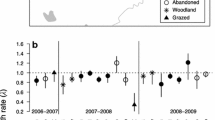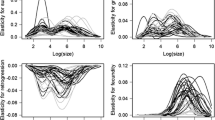Abstract
The population dynamics of two polycarpic perennials,Agrimonia eupatoria and Geum rivale, characteristic ofsemi-natural grasslands in Scandinavia, were examined in south-eastern Sweden.The perennial forbs were studied for several years in two populations each,located in habitats characteristic for the species in the study area.Demographic transition probabilities varied significantly between populationsand among years for the species. Transition matrix modelling yieldedλ-values (population growth rates) that ranged from 0.89 to 1.14 forA. eupatoria and from 0.94 to 1.04 for G.rivale. The elasticity analysis showed that stasis in the adultstageclasses contributed most to λ. The life-table response experimentanalysis produced similar results as the elasticity analysis, where stasistogether with progression in the adult stage classes made a large contributionto the observed spatial variation in λ. Simulations of expected time toextinction were in the order of centuries for the study populations. Seedlingrecruitment was enhanced by seed addition and small scale disturbance inpopulations. For the intermediately abundant and more patchily distributedA. eupatoria, a regional survey of local populations wasconducted in the study area which revealed that most populations wererelativelysmall (< 100 individuals) and restricted to grassland fragments in roadverges. Furthermore, an attempt was made to estimate fruit dispersal from localpopulations.
Similar content being viewed by others
References
Alvarez-Buylla E.R., García-Barrios R., Lara-Moreno C. and Martínez-Ramos M. 1996. Demographic and genetic models in conservation biology: applications and perspectives for tropical rain forest trees. Annual Review of Ecology and Systematics 27: 387-421.
Bengtsson K. 1993. Fumana procumbens on Öland-population dynamics of a disjunct species at the northern limit of its range. Journal of Ecology 81: 745-758.
Caswell H. 1989. Matrix population models: construction, analysis and interpretation. Sinauer, Sunderland.
Caswell H. 2000. Prospective and retrospective perturbation analyses: their roles in conservation biology. Ecology 81: 619-627.
Charron D. and Gagnon D. 1991. The demography of northern populations of Panax quinquefolium (American ginseng). Journal of Ecology 79: 431-445.
Cook R.E. 1985. Growth and development in clonal plant populations. In: Jackson J.B.C., Buss L.W. and Cook R.E. (eds), Population Biology and Evolution of Clonal Organisms. Yale University Press, New Haven, pp. 254-296.
Crawley M.J. 1990. The population dynamics of plants. Philosophical Transactions of the Royal Society of London, Series B. 330: 125-140.
de Kroon H., Plasier A. and Van Groenendael J. 1987. Density dependent simulation of the population dynamics of a perennial grassland species, Hypochoeris radicata. Oikos 50: 3-12.
de Kroon H., Plaisier J., Van Groenendael J. and Caswell H. 1986. Elasticity: the relative contribution of demographic parameters to population growth rate. Ecology 67: 1427-1431.
Ehrlén J. 1995. Demography of the perennial herb Lathyrus ver-nus: II. herbivory and population dynamics. Journal of Ecology 83: 287-295.
Ehrlén J. 1999. Modelling and measuring plant life histories. In: Vuorisalo T.O. and Mutikainen P.K. (eds), Life history evolution in plants. Kluwer Academic Publishers, Dordrecht, pp. 27-61.
Ehrlén J. and Van Groenendael J.M. 1998. The trade-off between dispersability and longevity-an important aspect of plant species diversity. Applied Vegetation Science 1: 29-36.
Ehrlén J. and Eriksson O. 2000. Dispersal limitation and patch occupancy in forest herbs. Ecology: in press (in press).
Ekstam U., Aronsson M. and Forshed N. 1988. Ängar. LT förlag, Stockholm, (Meadows; in Swedish).
Eriksson Å. and Eriksson O. 1997. Seedling recruitment in semi-natural pastures: the effects of disturbance, seed size, phenology and seed bank. Nordic Journal of Botany 17: 469-482.
Eriksson Å. and Eriksson O. 2000. Population dynamics of the perennial Plantago media in semi-natural grasslands. Journal of Vegetation Science 11: 245-252.
Eriksson Å., Eriksson O. and Berglund H. 1995. Species abundance patterns of plants in Swedish semi-natural pastures. Ecography 18: 310-317.
Eriksson O. 1989. Seedling dynamics of life histories in clonal plants. Oikos 55: 231-238.
Eriksson O. 1994. Stochastic population dynamics of clonal plants: numerical experiments with ramet and genet models. Ecological Research 9: 257-268.
Eriksson O. 1996. Regional dynamics of plants: a review of evidence for remnant, source-sink and metapopulations. Oikos 77: 248-258.
Eriksson O. and Ehrlén J. 1992. Seed and microsite limitation of recruitment in plant populations. Oecologia 91: 360-364.
Eriksson O. and Kiviniemi K. 1999. Site occupancy, recruitment and extinction tresholds in grassland plants: an experimental study. Biological Conservation 87: 319-325.
Grime J.P., Hodgson J.G. and Hunt R. 1988. Comparative Plant Ecology. Unwin Hyman, London.
Hanski I.A. and Gilpin M.E. 1997. Metapopulation Biology. Ecology, Genetics and Evolution. Academic Press, San Diego.
Harper J.L. 1977. Population Biology of Plants. Academic Press, London.
Horwitz C. and Schemske D.W. 1995. Spatiotemporal variation in demographic transitions of a tropical understory herb: projection matrix analysis. Ecological Monographs 65: 155-192.
Horwitz C., Schemske D.W. and Caswell H. 1997. The relative “importance” of life-history stages to population growth: prospective and retrospective analyses. In: Tuljapurkar S. and Caswell H. (eds), Structured-Population Models in Marine, Terrestrial, and Freshwater Systems. Chapman & Hall, New York, pp. 247-271.
Husband B.C. and Barrett S.C.H. 1996. A metapopulation perspective in plant population biology. Journal of Ecology 84: 461-469.
Husband B.C. and Barrett S.C.H. 1998. Spatial and temporal variation in population size of Eichornia paniculata in ephemeral habitats: implications for metapopulation dynamics. Journal of Ecology 86: 1021-1031.
Ihse M. 1995. Swedish agricultural landscapes-patterns and changes during the last 50 years, studied by aerial photos. Landscape and Urban Planning 31: 21-27.
Inghe O. and Tamm C.O. 1985. Survival and flowering of perennial herbs. IV. The behaviour of Hepatica nobilis and Sanicula europea on permanent plots during 1943-1981. Oikos 45: 400-420.
Kiviniemi K. 1996. A study of adhesive seed dispersal under natural conditions. Acta Botanica Neerlandica 45: 73-83.
Kiviniemi K. and Telenius A. 1998. Experiments on adhesive dispersal by wood mouse: seed shadows and dispersal distances of 13 plant species from cultivated areas in southern Sweden. Ecography 21: 108-116.
Kiviniemi K. and Eriksson O. 1999. Dispersal, recruitment and site occupancy of grassland plants in fragmented habitats. Oikos 86: 241-253.
Lid J. and Lid D.T. 1994. Norsk flora. Det Norska Samlaget, Oslo.
Menges E.S. 1990. Population viability analysis for an endangered plant. Conservation Biology 4: 52-62.
Menges E.S. 1998. Evaluating extinction risks in plant populations. In: Fiedler P.L. and Kareiva P.M. (eds), Conservation Biology for the Coming Decade. 2nd edn. Chapman and Hall, New York, pp. 49-65.
Menges E.S. 2000. Population viability analyses in plants: challenges and opportunities. Trends in Ecology and Evolution 15: 51-56.
Menges E.S. and Dolan R.W. 1998. Demographic viability of populations of Silene regia in midwestern prairies: relationships with fire managements, genetic variation, geographic location, population size and isolation. Journal of Ecology 86: 63-78.
Meyer A.H. and Schmid B. 1999a. Seed dynamics and seedling establishment in the invading perennial Solidago altissima under different experimental treatments. Journal of Ecology 87: 28-41.
Meyer A.H. and Schmid B. 1999b. Experimental demography of rhizome populations of establishing clones of Solidago altissima. Journal of Ecology 87: 42-54.
Milberg P. and Persson T. 1994. Soil seed bank and species recruitment in road verge grassland vegetation. Annales Botanici Fennici 31: 155-162.
Nantel P., Gagnon D. and Andrée N. 1996. Population viability analysis of American ginseng and wild leek harvested in stochastic environments. Conservation Biology 10: 608-621.
Nunney L. and Campbell K.A. 1993. Assessing minimum viable Population Size: Demography Meets Population Genetics. Trends in Ecology and Evolution 8: 234-239.
Oostermeijer J.G.B., Brugman M.L., De Boer E.R. and Den Nijs H.C.M. 1996. Temporal and spatial variation in the demography of Gentiana pneumonanthe, a rare perennial herb. Journal of Ecology 84: 153-166.
Ouborg N.J. 1993. Isolation, population size and extinction: the classical and metapopulation approaches applied to vascular plants along the Dutch Rhine-system. Oikos 66: 298-308.
Overton J, McC. 1994. Dispersal and infection in mistletoe metapopulations. Journal of Ecology 82: 933-950.
Primack R.B. and Miao S.L. 1992. Dispersal can limit local plant distribution. Conservation Biology 6: 513-519.
Quinn R.M., Lawton J.R., Eversham B.C. and Wood S.N. 1994. The biography of scarce vascular plants in Britain with respect to habitat preference, dispersal ability and reproductive biology. Biological Conservation 70: 149-157.
Schemske D.W., Husband B.C., Ruckelhaus M.H., Goodwillie C., Parker I.M. and Bishop J.G. 1994. Evaluating approaches to the conservation of rare and endangered plants. Ecology 75: 584-606.
Silvertown J., Franco M., Pisanty I. and Mendoza A. 1993. Comparative plant demography-relative importance of life-cycle components to the finite rate of increase in woody and herbaceous perennials. Journal of Ecology 81: 465-476.
Silvertown J., Franco M. and Menges E. 1996. Interpretation of elasticity matrices as an aid to the management of plant populations for conservation. Conservation Biology 10: 591-597.
Soulé M.E. 1987. Viable Populations for Conservation. Cambridge University Press, Cambridge.
Taylor K. 1997. Geum rivale L. Journal of Ecology 85: 721-731.
Tilman D., May R.M., Lehman C.L. and Nowak M.A. 1994. Habitat destruction and the extinction debt. Nature 371: 65-66.
Valverde T. and Silvertown J. 1997a. An integrated model of demography, patch dynamics and seed dispersal in a woodland herb, Primula veris. Oikos 80: 67-77.
Valverde T. and Silvertown J. 1997b. A metapopulation model for Primula veris, a temperate forest understory herb. Journal of Ecology 85: 193-210.
van der Meijden E., Klinkhamer P.G.L., De Jong T.J. and Van Wijk C.A.M. 1992. Meta-population dynamics of biennial plants: how to exploit temporary habitats. Acta Botanica Neerlandica 41: 249-270.
van Dorp D. 1996. Seed dispersal in agricultural habitats and the restoration of species-rich meadows.
Venable D.L. and Brown J.S. 1993. The population-dynamic functions of seed dispersal. Vegetatio 107/108: 31-55.
Verkaar H.J. 1990. Corridors as a tool for plant species conservation? In: Bunce R.G.H. and Howard D.C. (eds), Species Dispersal in Agricultural Habitats. Belhaven Press, London, pp. 82-97.
Author information
Authors and Affiliations
Rights and permissions
About this article
Cite this article
Kiviniemi, K. Population dynamics of Agrimonia eupatoria and Geum rivale, two perennial grassland species. Plant Ecology 159, 153–169 (2002). https://doi.org/10.1023/A:1015506019670
Issue Date:
DOI: https://doi.org/10.1023/A:1015506019670




